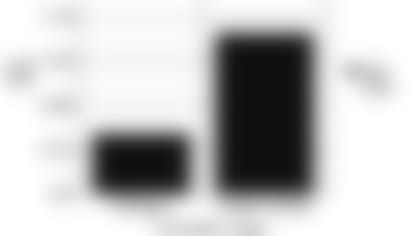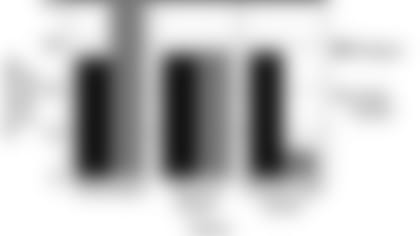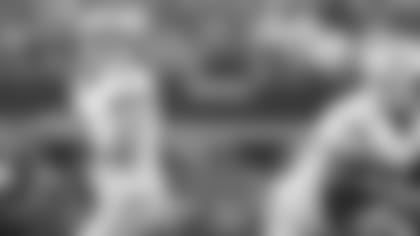The Cowboys compiled a 4-1 record when they remained relatively balanced in 2012, passing the ball on fewer than 57 percent of plays. That seems like pretty straightforward evidence that the offense should enter games with a balanced attack, but it isn't. As I explained in my **dissection of the Cowboys’ 2012 run/pass balance**, there's a mighty difference between correlation and causation; rushing the ball often is correlated with winning, but it isn't a cause of it. Actually, when the 'Boys start games by running the ball frequently, they typically lose.
Some of you have taken that as evidence that stats lie, but it's important to know that the numbers are never "wrong." Rather, they can be misleading if we interpret them the wrong way. In the case of the run/pass ratio, it's enticing to interpret end-game stats as being representative of a preferred in-game strategy, but the truth is that the majority of the league's best teams win games by passing often to gain a lead and then running to milk the clock. There are always exceptions, but those teams that purposely try to maintain balance, or win time of possession, often lose. The best offenses win time of possession because they're already good, not because trying to drain the clock leads to victories (it often just does the opposite).
I think such a distinction between correlation and causation is an important one, especially for today's topic: Shotgun passes. There's a pretty widespread consensus that using Shotgun formations is a sub-optimal strategy that is high-risk and leads to lots of turnovers. That idea isn't really all that shocking when you glance at the numbers.

In 2012, Tony Romo threw 13 of his 19 interceptions from a Shotgun formation (68.4 percent). It's no wonder that people associate Shotgun formations with turnovers. On top of that, the Cowboys' Shotgun passing stats were worse than when Romo remained under center.
Above, I sorted the Cowboys' passes according to formation. Net yards per attempt (YPA) adds sacks into the passing stats, so it's a good measure of total passing efficiency. The Cowboys totaled 6.79 net-YPA from Shotgun formations in 2012, compared to 7.11 net-YPA when Romo stayed under center.
Just for fun, I sorted all of the Shotgun dropbacks by quarter.
First Quarter
- 74 dropbacks, 1 scramble for 15 yards, 3 sacks for -23 yards, 46-for-70 (65.7 percent) for 521 yards (6.82 net-YPA)
Second Quarter
- 124 dropbacks, 1 scramble for 10 yards, 7 sacks for -56 yards, 73-for-116 (62.9 percent) for 897 yards (6.84 net-YPA)
Third Quarter
- 107 dropbacks, 2 scrambles for 4 yards, 6 sacks for -49 yards, 67-for-99 (68.0 percent) for 734 yards (6.52 net-YPA)
Fourth Quarter
- 184 dropbacks, 3 scrambles for 13 yards, 9 sacks for -66 yards, 115-for-172 for (66.9 percent) for 1,316 yards (6.91 net-YPA)
The abundance of Shotgun passes in the fourth quarter isn't really surprising since the team was losing late in so many games, and thus forced to throw. That got me to thinking: Could the Cowboys' Shotgun inefficiencies be due more to game situations than anything inherent to the formation itself?
Let's go back to Romo's interceptions. Although 13 of the 19 picks came from Shotgun looks, it might surprise you to know that 70.2 percent of Romo's 2012 passes were out of Shotgun. That means that Romo actually had a slightly lower interception rate when throwing out of Shotgun as compared to when he was under center. That's especially relevant since many of the Shotgun formations came in low-upside situations – such as down big in the fourth quarter – when Romo would be more inclined to take chances. Actually, all four of Romo's fourth quarter interceptions came from a Shotgun formation.

When we examine the Shotgun plays according to down, the difference in game situations becomes clearer.
While the Cowboys' plays from Shotgun were pretty much evenly distributed across each down, the offense ran way more plays under center on early downs; 58.0 percent of their under-center plays came on first down, 34.3 percent on second down, and 7.7 percent on third down.
That's a really big deal because, as you might imagine, quarterbacks have far more success passing the ball on first down, when it might be unexpected, than on later downs. Actually, quarterbacks across the league generated 7.35 YPA on first down passes in 2012, compared to 6.90 on second down and 6.93 on third down.
After accounting for game situations, it turns out that Shotgun was actually slightly more efficient than under-center formations when the Cowboys passed the ball last season. Romo's Shotgun adjusted YPA (accounting for down) was higher, he recorded a lower interception rate, and even the sack rate was slightly lower than when he lined up under center. That fits well with past data for the team and across the league, which suggests that Shotgun is actually underutilized.
None of this is to suggest that the Cowboys need to line up in Shotgun every time they want to pass. Passing the ball from double-tight, run-oriented formations can be incredibly advantageous, especially in short-yardage situations. But the idea that passing the ball from Shotgun is inherently suboptimal to lining up under center simply isn't true. The dip we see in Shotgun passing stats for the Cowboys and across the NFL is due to the situations in which it's used, not a weakness of the formation.















